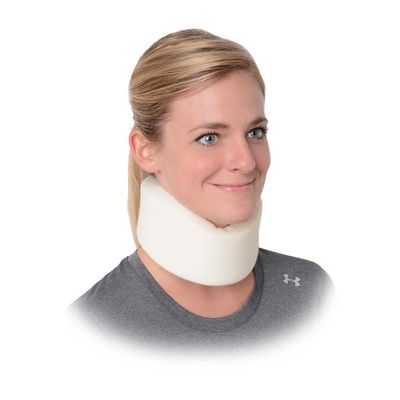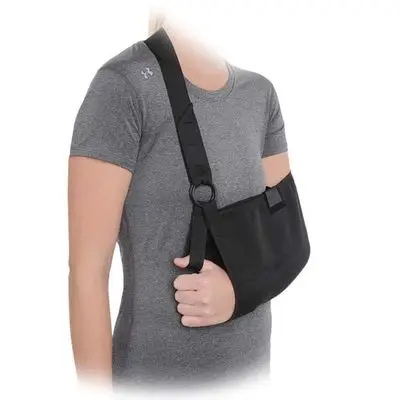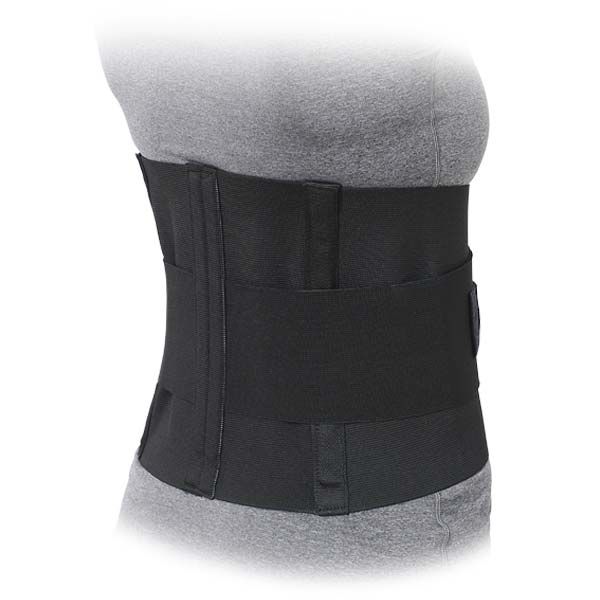Table of Contents
Arm Sling
An arm sling is a supportive medical device designed to immobilize and support the arm, typically after an injury, surgery, or when recovering from a condition that affects the arm, shoulder, or wrist. Slings are commonly used to help reduce pain, prevent further injury, and facilitate healing by keeping the arm in a neutral and stable position.
Uses of an Arm Sling
- Post-Surgery Recovery: After surgeries such as shoulder repairs, rotator cuff surgery, or elbow procedures, an arm sling helps immobilize the area and prevent unnecessary movement.
- Fractures: Used for fractures of the arm, collarbone (clavicle), or shoulder blade (scapula) to keep the arm stable while healing.
- Dislocations: A sling can help immobilize the arm after a shoulder or elbow dislocation, preventing further injury and allowing the joint to heal.
- Strains and Sprains: Slings provide support for muscles or ligaments that have been strained or sprained, limiting movement to promote healing.
- Chronic Conditions: Conditions like arthritis or bursitis may require the use of a sling to reduce strain on the affected joints.
Types of Arm Slings
Standard Arm Sling
- Design: A simple fabric pouch that supports the forearm, secured with a strap that goes around the neck or shoulder.
- Uses: Common for mild injuries, fractures, or post-surgical recovery.
Shoulder Immobilizer Sling
- Design: Includes a strap that wraps around the waist to prevent the arm from moving away from the body.
- Uses: Often used after shoulder surgeries or dislocations to fully immobilize the shoulder joint.
Abduction Sling
- Design: A specialized sling with a pillow or wedge that keeps the arm slightly away from the body (abducted position).
- Uses: Typically prescribed after rotator cuff surgery or shoulder replacements to prevent internal rotation.
Elbow Immobilizer Sling
- Design: Focuses on stabilizing the elbow and limiting its movement, often with additional support at the elbow joint.
- Uses: Useful for elbow fractures or ligament injuries.
Benefits of an Arm Sling:
- Immobilization: Prevents movement of the injured arm, reducing pain and promoting healing.
- Pain Reduction: Keeping the arm in a stable position can help alleviate discomfort from injuries or surgical procedures.
- Support: Provides structural support for fractures, sprains, or muscle tears.
- Injury Prevention: Reduces the risk of further injury during the healing process by limiting movement.
Proper Usage Tips
- Positioning: The elbow should be at a 90-degree angle, and the hand should be slightly elevated above the elbow to reduce swelling.
- Comfort: The strap should not place excessive pressure on the neck; some slings come with padded straps to prevent neck strain.
- Doctor’s Instructions: Follow your healthcare provider’s recommendations regarding the duration of use and specific care instructions for your injury.
Arm slings are an essential tool for anyone recovering from upper limb injuries or surgeries, providing the necessary support and immobilization to aid in healing.
Lumbar Sacral = Back Support W/ Side Pulls
A back support with side pulls is a type of orthopedic brace designed to provide stability, compression, and support to the lower back, particularly in cases of lower back pain, injury, or strain. The addition of side pulls allows for adjustable compression and increased support, helping to alleviate pain and promote proper posture.
Key Features of a Back Support with Side Pulls
Adjustable Side Pulls
- Side pulls are adjustable straps or laces that allow users to tighten or loosen the brace as needed. This feature provides customizable compression and support to the lower back, enhancing comfort and effectiveness.
- The side pulls allow for easy adjustments throughout the day, accommodating changes in comfort level or activity.
Lumbar Support
- The brace is designed to target the lumbar region (lower back), providing support to the spine and surrounding muscles. This can help reduce stress on the back and prevent further injury.
Compression
- The compression provided by the brace helps reduce swelling and inflammation, which can lead to pain relief. Compression also promotes better posture and can improve muscle engagement in the lower back.
Breathable Material
- Many back supports with side pulls are made from breathable, moisture-wicking materials to ensure comfort during extended use. This helps reduce heat buildup and prevents skin irritation.
Ergonomic Design
- Designed to fit the natural curves of the back, the support is contoured to provide a snug and comfortable fit. The side pulls enable adjustments to fit a variety of body shapes and sizes.
Velcro or Hook-and-Loop Fastening
- The brace is usually secured with Velcro or hook-and-loop fasteners, allowing users to easily adjust the tightness for optimal support.
Uses of a Back Support with Side Pulls
Lower Back Pain Relief
- Ideal for people suffering from lower back pain due to muscle strain, overuse, or conditions like sciatica or herniated discs. The side pulls provide extra support to stabilize the lower back and alleviate pain.
Posture Improvement
- Helps correct poor posture by providing lumbar support and encouraging a more upright position. This can be particularly helpful for individuals who spend long hours sitting or standing in improper positions.
Injury Prevention
- Used by athletes, manual laborers, or individuals who perform heavy lifting to prevent lower back injuries. The brace adds extra stability to the spine and reduces the risk of strain or injury.
Post-Surgical Support
- Provides stability and reduces strain on the lower back following surgery or injury, promoting a faster recovery and preventing reinjury.
Chronic Back Conditions
- Beneficial for individuals with chronic back conditions such as degenerative disc disease, osteoarthritis, or lumbar stenosis. The adjustable side pulls allow for consistent support based on the level of discomfort.
Benefits of Back Support with Side Pulls
- Customizable Compression: The adjustable side pulls enable the user to tighten or loosen the brace, providing the right amount of compression based on activity level or pain.
- Improved Stability: By stabilizing the lower back and promoting proper posture, the brace helps reduce strain on the spine and surrounding muscles.
- Pain Relief: Compression and support can alleviate pain caused by injury, muscle strain, or chronic back conditions.
- Enhanced Mobility: Many users find that the brace allows them to continue daily activities with less pain, while still supporting their back.
How to Use a Back Support with Side Pulls
- Position the Brace: Center the back support over your lower back (lumbar region), ensuring it is sitting comfortably.
- Fasten the Brace: Secure the front closure (typically Velcro) around your abdomen. The brace should fit snugly but not too tight to restrict breathing or movement.
- Adjust Side Pulls: Tighten or loosen the side pulls as needed to customize the level of compression and support. Make sure the brace feels secure and provides adequate support without causing discomfort.
- Wear During Activity: Use the back support during activities that may strain your lower back, such as lifting, bending, or prolonged sitting/standing. You can also wear it during exercise if advised by a healthcare provider.
- Do Not Overuse: While a back support can be helpful for pain relief and injury prevention, it’s important not to become overly reliant on the brace. Overuse can lead to weakened back muscles. Gradually work on strengthening your back through physical therapy or exercises.
Care and Maintenance
- Follow the manufacturer’s instructions for cleaning and maintaining the back support. Most are hand-washable or machine-washable in a gentle cycle.
- Ensure that the brace is fully dry before wearing it again to prevent skin irritation or damage to the materials.
A back support with side pulls can be an effective tool for managing back pain, supporting posture, and preventing injury. It’s ideal for those with lower back issues who need adjustable support for varying levels of activity and comfort.
ORDER NUMBER: 501-W, 503-W, 505-W, 507-W, 507-W, 508-W, 509-W, 510-W, 511-W, 512-W
501-B, 503-B, 505-B, 507-B, 508-B, 509-B, 510-B, 511-B, 512-B
SIZE: X-Small thru 5X Large (see sizing chart to the left)
PRODUCT HIGHLIGHTS:
• Form-fitting 10" all-elastic with double pull side panels for additional support
• High quality Velcro™ closure for durability
• Four flexible stays in back panel for excellent support
INDICATIONS:
Ideal for providing support and compression for strains and sprains of the lower back.
SUGGESTED HCPC: L0625
Categories: Cervical, Spine & Abdominal


Arm pain can result from a variety of causes, ranging from muscle strain to more serious conditions like nerve injuries or cardiovascular issues. The pain can be mild or severe, sharp or dull, and may be accompanied by other symptoms depending on the underlying cause.
Common Causes of Arm Pain
Muscle Strain or Overuse
- Cause: Overexertion from physical activities, heavy lifting, or repetitive motions (e.g., sports, typing, or manual labor).
- Symptoms: Aching, soreness, or stiffness in the muscles. Pain may worsen with movement.
- Treatment: Rest, ice, compression, elevation (RICE method), and over-the-counter pain relievers.
Injury or Trauma
- Cause: Fractures, sprains, or dislocations due to falls, accidents, or direct impact.
- Symptoms: Intense pain, swelling, bruising, and difficulty moving the arm.
- Treatment: Seek medical attention for diagnosis and treatment. Fractures and dislocations may require casting, slings, or surgery.
Nerve Compression (e.g., Pinched Nerve)
- Cause: Nerve compression in the neck or shoulder area (cervical radiculopathy) or conditions like carpal tunnel syndrome.
- Symptoms: Tingling, numbness, burning pain, or weakness in the arm, often radiating from the neck or shoulder.
- Treatment: Physical therapy, anti-inflammatory medications, or in severe cases, surgery.
Tendonitis or Bursitis
- Cause: Inflammation of tendons (tendonitis) or bursae (bursitis) due to overuse or repetitive motion.
- Symptoms: Localized pain around the joints, especially with movement or pressure.
- Treatment: Rest, anti-inflammatory medications, and sometimes corticosteroid injections.
Rotator Cuff Injuries:
- Cause: Damage or tears in the shoulder’s rotator cuff, often from repetitive overhead movements or aging.
- Symptoms: Dull ache deep in the shoulder, pain when lifting the arm, and difficulty reaching behind the back.
- Treatment: Physical therapy, anti-inflammatory medications, or surgery in severe cases.
Heart-Related Causes (e.g., Heart Attack):
- Cause: Arm pain, particularly in the left arm, can be a symptom of a heart attack or angina.
- Symptoms: Pain radiating from the chest to the left arm, jaw, or back, along with shortness of breath, sweating, or nausea.
- Treatment: Seek emergency medical attention immediately.
Frozen Shoulder (Adhesive Capsulitis)
- Cause: Stiffness and pain in the shoulder joint, often progressing over time.
- Symptoms: Pain and restricted movement in the shoulder, which can radiate to the arm.
- Treatment: Physical therapy, anti-inflammatory medications, or surgery in advanced cases.
Osteoarthritis:
- Cause: Wear and tear of cartilage in the joints, commonly affecting the shoulders or elbows.
- Symptoms: Pain, stiffness, and reduced range of motion in the affected joint.
- Treatment: Pain management, physical therapy, and sometimes joint replacement surgery.
Referred Pain
- Cause: Pain in the arm caused by issues in other areas, such as the neck or spine.
- Symptoms: Pain that originates in the neck or spine but is felt in the arm.
- Treatment: Treat the underlying cause, such as cervical disc problems or nerve issues.
When to Seek Medical Attention
- Sudden, severe pain: Especially if it’s accompanied by chest pain, shortness of breath, or dizziness (potential heart attack).
- Pain after injury: If you suspect a fracture, dislocation, or severe sprain.
- Numbness or weakness: Persistent tingling, numbness, or muscle weakness may indicate nerve involvement.
- Swelling or deformity: Noticeable swelling, bruising, or visible deformities after trauma.
Treatment Options
- Rest: Avoid activities that aggravate the pain.
- Ice/Heat Therapy: Ice packs for the first 48 hours to reduce swelling, followed by heat to relax muscles.
- Pain Relievers: Over-the-counter medications like ibuprofen or acetaminophen.
- Physical Therapy: Exercises to strengthen the muscles and improve range of motion.
- Braces or Slings: Temporary support to immobilize the arm and promote healing.
- Surgery: For severe cases like fractures, dislocations, or tendon tears.
Prevention Tips
- Proper Ergonomics: Ensure good posture when working at a desk or using devices.
- Stretching and Strengthening: Regular exercises to strengthen arm and shoulder muscles.
- Avoid Repetitive Strain: Take breaks and use proper form during physical activities.
- Use Supportive Devices: Use braces or slings as recommended for injury prevention and recovery.
If arm pain persists or worsens, it’s important to consult with a healthcare professional for proper diagnosis and treatment.


